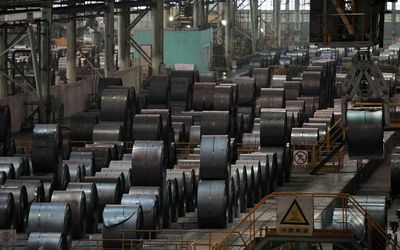Liquidity problems bite in China’s steel sector
by Lucy Hornby,
2014-02-27 05:44:17.0
BEIJING — Iron ore prices have dropped to a seven-month low amid concerns about waning demand from China, the world’s top consumer of the steel-making ingredient.
China now accounts for almost half of global steel production. Its mills’ hunger for iron ore, a key ingredient, determines the strength of the Australian dollar, the cost of ocean freight, and the profitability of mining in South America. Any hint that the Chinese steel boom has peaked sends iron ore prices skittering.
But after years of breakneck expansion, liquidity problems have started to bite. Some private mills in Tangshan, home to about a quarter of China’s steel capacity, are empty and silent after owners ran out of cash to pay workers.
Xu Zhongbo, head of Beijing Metal Consulting, estimates that 40m-50m tonnes of long steel capacity have been idled as production costs exceed prices by $16.30/tonne.
Already, the prospect of slower Chinese steel growth and the arrival of new supplies from mines in Australia is weighing on prices. on Wednesday the benchmark 62% iron ore price, as assessed by The Steel Index, fell to a seven-month low of $119/tonne, taking losses this year to 13%.
"Steel overcapacity probably exceeds our imagination," warned Li Xinchuang of the China Iron and Steel Association at a Metal Bulletin conference.
Another concern is the rise in iron ore stocks at Chinese ports to record levels. One interpretation is that the mountains of ore piling up at ports reflect the cash crunch at steel-mills, which are only buying raw material as needed.
Some desperate steel mills are also using iron ore imports as a crutch to keep cash flowing. Chinese property developers are famous for importing copper, zinc, rubber or palm oil just to access letters of credit, which they use like short-term loans to stay solvent long enough to bring projects to market. Some steel mills have adopted the practice.
Still, there are signs the party is not over yet for the seaborne iron ore market. The association predicts a 3.2% rise in steel products output to 715-million tonnes would fuel a 6% rise in iron ore imports this year. That is partly due to Beijing’s environmentally destructive policy of promoting domestic iron ore mining while restricting the access of small mills to better-quality imports. Even though China’s reported iron ore production has soared, its quality has declined sharply.
Pan Guocheng, CE of Hanking Group, which owns nine mines in Liaoning province, estimates that China’s dependence on iron ore imports will rise to 77% by 2016, from 72% now.
Financial Times

A stainless steel product line is seen at a factory of Baosteel Group Corp, China's biggest steel maker, in Shanghai in this July 6 2010 file photo. Picture: REUTERS
BEIJING — Iron ore prices have dropped to a seven-month low amid concerns about waning demand from China, the world’s top consumer of the steel-making ingredient.
China now accounts for almost half of global steel production. Its mills’ hunger for iron ore, a key ingredient, determines the strength of the Australian dollar, the cost of ocean freight, and the profitability of mining in South America. Any hint that the Chinese steel boom has peaked sends iron ore prices skittering.
But after years of breakneck expansion, liquidity problems have started to bite. Some private mills in Tangshan, home to about a quarter of China’s steel capacity, are empty and silent after owners ran out of cash to pay workers.
Xu Zhongbo, head of Beijing Metal Consulting, estimates that 40m-50m tonnes of long steel capacity have been idled as production costs exceed prices by $16.30/tonne.
Already, the prospect of slower Chinese steel growth and the arrival of new supplies from mines in Australia is weighing on prices. on Wednesday the benchmark 62% iron ore price, as assessed by The Steel Index, fell to a seven-month low of $119/tonne, taking losses this year to 13%.
"Steel overcapacity probably exceeds our imagination," warned Li Xinchuang of the China Iron and Steel Association at a Metal Bulletin conference.
Another concern is the rise in iron ore stocks at Chinese ports to record levels. One interpretation is that the mountains of ore piling up at ports reflect the cash crunch at steel-mills, which are only buying raw material as needed.
Some desperate steel mills are also using iron ore imports as a crutch to keep cash flowing. Chinese property developers are famous for importing copper, zinc, rubber or palm oil just to access letters of credit, which they use like short-term loans to stay solvent long enough to bring projects to market. Some steel mills have adopted the practice.
Still, there are signs the party is not over yet for the seaborne iron ore market. The association predicts a 3.2% rise in steel products output to 715-million tonnes would fuel a 6% rise in iron ore imports this year. That is partly due to Beijing’s environmentally destructive policy of promoting domestic iron ore mining while restricting the access of small mills to better-quality imports. Even though China’s reported iron ore production has soared, its quality has declined sharply.
Pan Guocheng, CE of Hanking Group, which owns nine mines in Liaoning province, estimates that China’s dependence on iron ore imports will rise to 77% by 2016, from 72% now.
Financial Times



















Change: -0.47%
Change: -0.57%
Change: -1.76%
Change: -0.34%
Change: 0.02%
Data supplied by Profile Data
Change: -1.49%
Change: 0.07%
Change: -0.47%
Change: 0.00%
Change: 0.04%
Data supplied by Profile Data
Change: 0.47%
Change: 1.16%
Change: 0.65%
Change: 0.15%
Change: 1.17%
Data supplied by Profile Data
Change: 0.11%
Change: -0.42%
Change: 0.13%
Change: -1.22%
Change: -0.87%
Data supplied by Profile Data